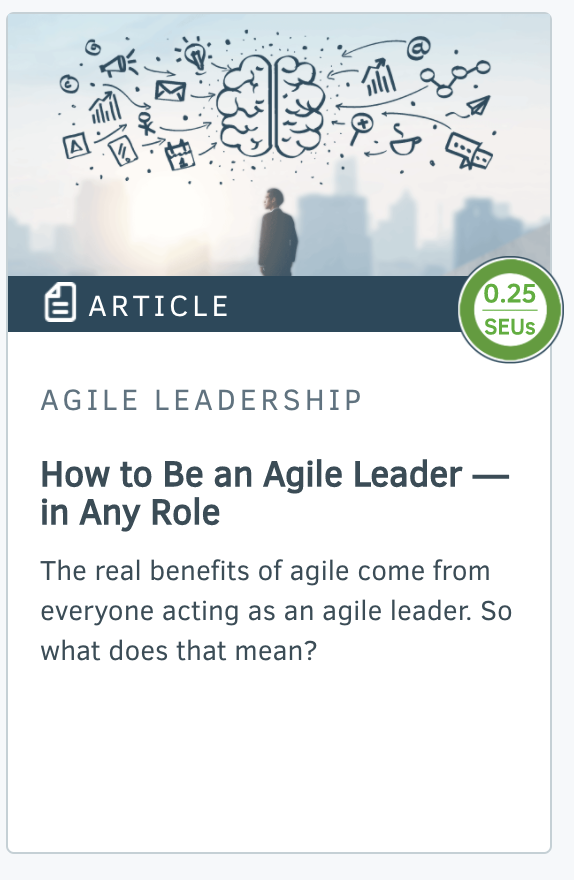How to Become a Catalyst Leader

In George Monbiot’s excellent video, he shares the story of an amazing change that happened in nature, when wolves were reintroduced to Yellowstone National Park in the United States after an absence of over 70 years.
The story highlights that creating change takes courage, as many people were afraid of the reintroduction of the wolves. It also helps us understand how a small group of wolves could be the catalyst for a huge change in nature.
Introducing agile into your organisation also takes courage, as many people within the organisation are afraid, some are excited, but most are both! As a leader, you are a change agent, part of a small group who can be the catalyst for huge changes.
So, let’s look at how creating change works, and then we will apply it to adopting agile in an organisation.
Leading change starts with yourself and ensuring that you truly believe in the change. For you to help others through change, you need to be comfortable that you understand why the change is happening and what it means to you personally.
Next, it’s about helping others through change, and understanding that each individual goes through the change process in their own way, as demonstrated by the Kubler-Ross five stage change model. The stages of change are natural for people to go through, and they last for different periods of time for each person.
To assist with navigating these stages, understanding people’s emotions, and not just creating rational arguments for the change are crucial. The Switch Model by Chip Heath is my favourite for this, where the emotional side of change is represented by the elephant and the rational side by the rider of the elephant. Motivating the elephant through connecting emotionally is the key, as shared in this short video.
For the change implementation, I like to use the Prosci’s ADKAR change model, which provides a neat framework to help plan the overall change approach and will also form the basis of the change impact assessment and communications plan. It starts with Awareness (the need for the change), then Desire (to participate and support the change), Knowledge (on how to change), Ability (to implement the desired skills and behaviours) and finally Reinforcement (to sustain the change).
Now we know how to create and plan for the change process, let’s bring it back to the adoption of agile in an organisation. The change usually starts either top-down or bottom-up.
In the top-down approach, senior management, often with the help and advice of external consultants, support, or at times “enforce” new ways of working with agile. This is usually a positive but look out for the enforcement of a “one size fits all” approach and ensure there is a way to choose the right agile framework for the type of work being performed.
With bottom up, teams in different pockets of the organisation experiment with different ways of working, and the adoption evolves and grows over time.
The creativity can get great results, but as we scale across the organisation, more alignment and consistency of frameworks is important. The bottom-up approach tends to take longer, and without support from the top it can fade out and die.
The catalyst leader brings both together, ensuring we have alignment at the top and autonomy from the bottom. There is a consistent framework for the organisation, but it allows for choice (i.e some teams select scrum, others kanban) and the support from top management provides funding for training and agile coaches to help embed the change.
Change is hard, that’s why agile transformations sometimes fail to deliver on expectations. As a catalyst leader, have the courage to voice your opinions on the change to agile, ensure you connect with the why, and use the change models like Switch and ADKAR to help your people navigate the path ahead. Remember, if wolves can change rivers, you can change the organisation for the better with agile and scrum!
Related Article
Article - How to Be an Agile Leader - in Any Role
======
About the author
Sam Bowtell is a Certified Scrum Trainer, Certified Agile Leader Educator working with RedAgile in Australia and AgileAsia in Singapore. Sam has been a people leader for over 25 years and has trained hundreds of leaders through the Certified Agile Leadership (CAL) training as well as many in-house agile leadership programs. Sam regularly speaks at conferences worldwide to share his learnings and philosophy on leadership…. focus on the people, care about, and include them all as equals, create safety for autonomy and innovation, build true relationships and bring a sense of energy and fun to the workplace.
Get the latest resources from Scrum Alliance delivered straight to your inbox
Subscribe